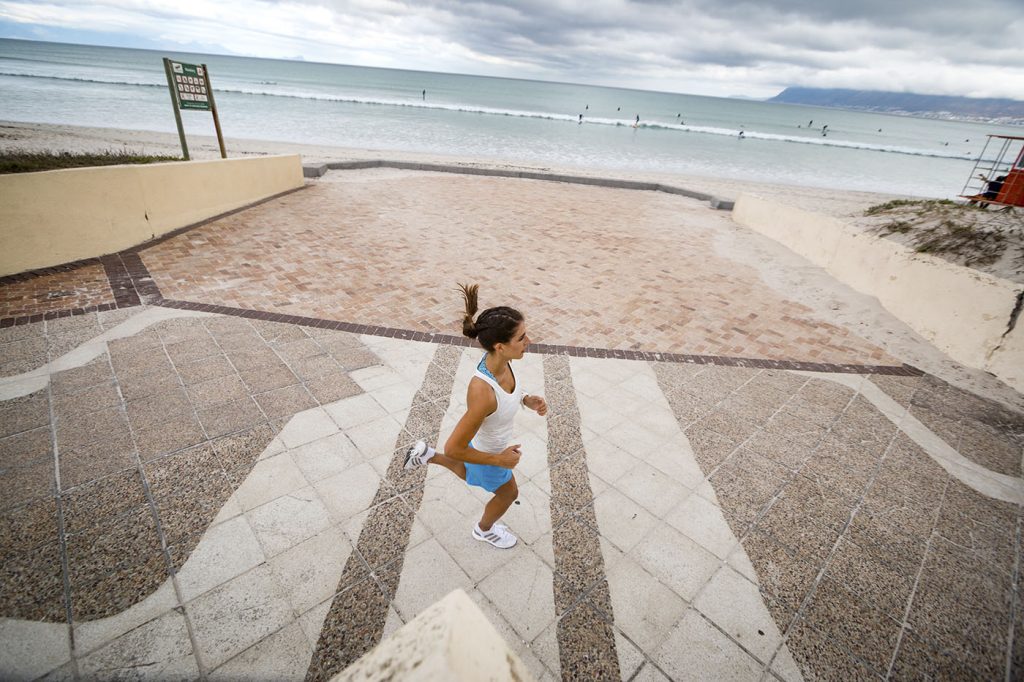Should You Change Your Stride Length?
Your gait may never look quite as gazelle-like as Kipchoge’s, but that doesn’t mean you’re less efficient.
One, two, one, two, one two… Running has a pretty obvious rhythm, but it’s pretty rare to see a group of runners in lockstep. Just like every runner’s body is different, every runner’s stride is unique to them. And finding the right stride length can help you run more efficiently, more safely, and maybe even faster.
What is stride length?
The word “stride” is used pretty casually among runners and is often confused with your gait or your step count. But “stride length is the distance covered between the spot where one foot hits the ground and the next time that same foot hits the ground again,” says Robert Maschi, an associate clinical professor in the Physical Therapy and Rehabilitation Sciences department at Drexel University and the leader of Drexel’s Running Performance and Research Centre.
That’s two steps – one with your right foot, one with your left. The number of steps you take is always twice the number of strides, and the number of steps you take per minute is called cadence.
It’s hard to think about – or tinker with – your stride length without also considering your cadence and pace, says Erika Lee Sperl, a kinesiologist and high-performance sport consultant for Orreco, a sports and data analytics company in Los Angeles. “If you’re maintaining the same pace but running with a shortened stride length, you’ll increase your cadence because you’ll be taking more steps per minute,” she explains. “If you lengthen your stride, you’ll be taking less steps per minute at the same pace.”

What is the ideal stride length?
The short answer: It depends. You’ve probably heard that an average of 180 steps per minute is the “magic number” for cadence. “This is based on observations by the famous running coach Jack Daniels, who wrote that the majority of elite distance runners at the 1984 Olympic games had a cadence of 180 foot strikes per minute and higher,” says Maschi. Recreational runners, though, tend to run with a cadence of 140-170 foot strikes per minute, he adds.
It’s actually not just the overall length of a step or a stride that’s important, says Maschi. “What’s most important is the position of the foot relative to the centre of your body (your centre of mass) when it contacts the ground,” he explains.
RELATED: How to Correct Overstriding
That’s because stride length functions on a bell curve. “Research has repeatedly shown that overstriding – that is, running with the leading foot extended too far in front of the body and thus hell striking – is a prime factor for increased risk of injury,” says Sperl. “Plus, overstriding places the body in a biomechanically inefficient position to move into the second stage of the gait cycle, and is subsequently less effective in generating forward momentum.”
On the flip side, if your stride length is too short, you can’t store enough energy in the swing phase of your gait, and you won’t be able to use as much force when you hit the push-off phase of your gait, which means you’ll have less forward momentum, Sperl explains.
What determines stride length?
Well, you do. Some people naturally prefer a longer stride, and others fall into a shorter stride.
While many people think stride length has to do with height or leg length, it’s not just runners with long legs who have a long stride and vice versa, says Maschi; research shows that runners with long legs can have a short stride, while shorter runners can have a long stride.
There are a lot of variables that go into the equation, including your individual biometrics: your overall height, the length of your legs, and running biomechanics like your foot strike, says Sperl. “Some of the other variables that determine stride length are body weight, flexibility, and stiffness (or how much the joints of the foot, knee, and hip move during the running gait,” says Maschi.
Plus, your stride length can change during a run, Maschi explains. As you go uphill, your steps tend to get shorter, and you take more of them. On the downhill, your steps will open up, and you’ll take fewer of them. When you generate more power, like during a sprint to the finish, your step length, cadence, or both can increase. And the more fatigued you get, the more your step length, cadence, or both usually decreases (hello, marathon shuffle).

So why does stride length matter?
Remember how stride length goes hand in hand with cadence and pace? “To run faster, a runner needs to either cover more ground with each step length, increase cadence, or a combination of both,” says Sperl.
But finding your ideal stride length and cadence isn’t just about gaining speed. It will also improve your efficiency. “At your ideal stride length and cadence, you’ll be able to run at the same pace with reduced heart rate and oxygen consumption,” explains Maschi. “That reduced heart rate and oxygen consumption would lead to a lower energy cost and effort while running.”
It also helps protect you from injury. “One of the most common injuries in runners is patellofemoral pain, or Runner’s Knee,” says Sperl. “And that’s very common when you have just a slight tendency to overstride – even if it’s not very obvious. Your knee is more extended when your foot hits the ground, so your leg is straighter and further in front of you. The way the force from the ground pushes back up through your body in that position can lead to increased risk of patellofemoral pain.”
Should you change your stride length?
Probably not. Whether you’re a new runner or an experienced one, the stride length you naturally choose is likely your most efficient, according to a 2017 study published in the International Journal of Exercise Science that compared runners’ preferred stride length to strides of plus and minus 8 and 16 percent of their normal stride length.
“The body is remarkably adept at remembering movement patterns, and this includes your stride length and steps per minute,” says Sperl. “Sometimes it’s counterproductive to try and change biomechanical patterns that have been ingrained for years.”
RELATED: 6 Common Injuries You Should Never Train Through
That said, if you can mess with your stride in the right direction, it could make you more efficient, says Maschi. Runners who increased their running cadence a small amount above their self-selected cadence immediately lowered their heart rate in a study published in PLOS One.

Increasing your cadence by 5 and 10 percent over your preferred cadence can also decrease overstriding and reduce impact and bracing forces to potentially avoid running-related injuries, research published in Medicine & Science in Sports & Exercise found.
If you do tend to overstride (if you’re constantly suffering from hamstring issues, that could be a clue), you may want to get a proper gait evaluation from a qualified physical therapist, biomechanical specialist, or kinesiologist, says Sperl.
FWIW, experienced runners tend to select a cadence that’s closer to optimal for energy expenditure than novice runners, says research published in the European Journal of Sport Science. “So it may take some practice to find your most optimal cadence and stride length,” says Maschi. Start by finding your current cadence, then play with taking five to 10 steps more or less,” says Sperl. A heart rate monitor and/or smartwatch can help you see where you’re most efficient.
READ MORE ON: injury-prevention running form stride

